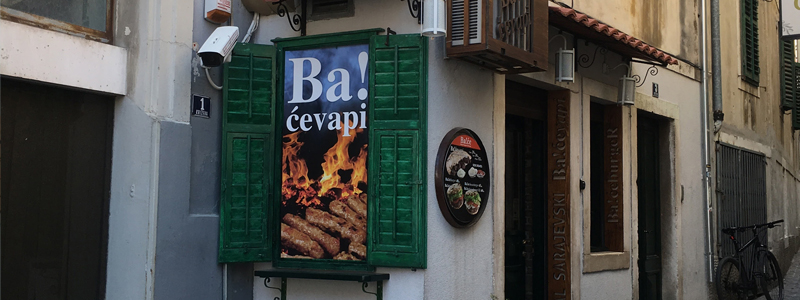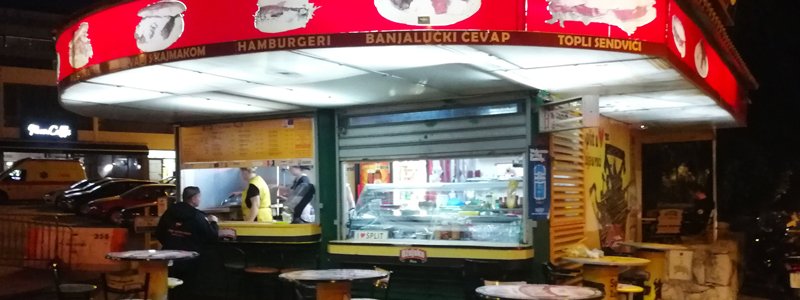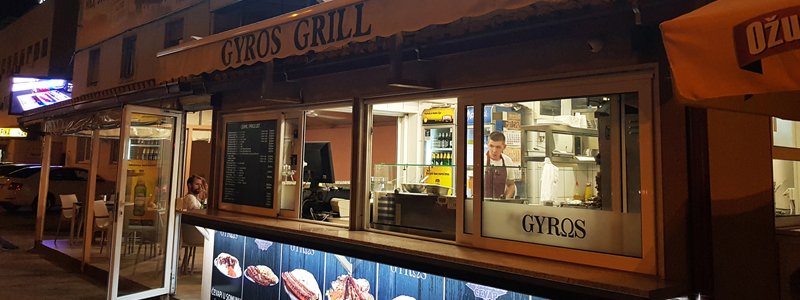A Brief History of Ćevapi
Considered by many to be the quintessential dish of the Balkans, like pizza or pasta are to Italy, ćevapi are popular with locals and tourists alike. Though being nothing more than minced meat, preferably beef or lamb, mixed with a little bit of sparkling water, finely minced onion and garlic, with a sprinkling of salt and pepper, ćevapi have developed an almost cult-like status throughout the countries of the former Republic of Yugoslavia.
But nowhere have ćevapi been so well received and ingrained in the local culture like in Bosnia and Herzegovina, where they have been transformed into the gastronomic symbol of the entire country. There, a number of regionally-specific ćevapi-making styles have developed in regional centers like Sarajevo, Banja Luka and Travnik. In recent years, an increasing number of tourists, particularly those hailing from ex-Yugoslav countries, have grown interested in gastronomic ‘pilgrimages’ to popular Sarajevo ćevapi restaurants, which are scattered around the city center called Baščaršija. Because of recent popularity of Bosnian styles, a great number of misconceptions has been created regarding the origins and early dissemination of ćevapi.
Recent studies on the origins of popular foods in the countries of former Yugoslavia have finally shed some light on these long-discussed issues. A couple of historians from Banja Luka, Bosnia and Herzegovina, Slavojka Beštić-Bronza and Boro Bronza have claimed that ćevapi as we know them today, have originated in the northwestern Ottoman frontiers, were the early fast food industry was booming in the major Ottoman cities of the region like Edirne, Thessaloniki, Skopje, Bitola, Sofia, Niš and Leskovac. Beštić-Bronza and Bronza have proposed, that ćevapi as we know them today actually originated from the small south Serbian town of Leskovac, which had been taken from the Ottomans and annexed into the Principality of Serbia in 1878. The town was and is to this day, famous for their tradition of preparing grilled meat dishes. In this interpretation of the ćevapi origin story, the diminutive term ćevapćići (lit. ‘small ćevapi) – popular particularly in Serbia and not so much in Croatia – appears to have been the original name of the dish which was coined in order to best describe the dish that was, essentially, a smaller version of the Turkish kebab.
Though ćevapi were first recorded in Belgrade, the capital of Serbia, back in 1860, it was only in 1880s and 1890s that the influx of emigrants from Leskovac brought forth a significant expansion of the ćevapi-making craft on the streets of Belgrade. The newly introduced dish, a staple of the booming early fast food industry, proved very popular locally and first street hawkers in Belgrade were able to make big money solely on ćevapi.
After the establishment of the Kingdom of Yugoslavia following World War I, the ćevapćići of Leskovac continued their journey westward, finding fertile ground in Bosnia and Herzegovina and by 1933, in Maribor, Slovenia. The great ćevapi expansion was eventually halted by the onset of World War II and, later on, by the implementation of the communist system in Yugoslavia which saw the abolishment of the private sector that has resulted in the closure of many of the early grill restaurants.
The wave of liberalization of socialist Yugoslavia that swept the country in the 1960s, brought forth the rise of the tourist industry and sparked new life into ćevapdžinice which gradually started popping up through the country, but found particular popularity in Bosnia and Herzegovina that eventually adopted the dish as almost a national symbol.
Croatian ćevapi culture lagged far behind and first ćevapi joints appear to have sprung up only after the dish had proved popular in Bosnia, as local copy-cat joints have attempted to recreate the taste that was growing increasingly associated with Bosnian towns. In fact, regional ćevapi-making styles of Bosnia have continued to enjoy great popularity in major Croatian cities, including Split, to this day, forming a large part of the market.
Ćevapi Styles
Because of their ad hoc popularity and lack of standards when the dish first spread around the country, a number of regional varieties developed in Bosnian large towns that eventually transformed into a kind of, self-branding. For example, the most famous style of ćevapi, the Sarajevo-style are shaped in the form of a finger, whereas Banja Luka-style would see them shaped in a flat piece made out of four ‘fingers’ put together, allegedly in order to create a softer and greasier texture. Likewise, Sarajevo-style ćevapi come with soft bread (lepinja/somun) that is always served dry, whereas in Banja Luka the bread comes dipped in sauce and oily fats of the grilled meat. Another locally popular style is the Travnik-style, which represents a crossover between the Sarajevo and the Banja Luka version. It is shaped into individual fingers like Sarajevo ćevapi, whereas the bread is dipped in sauce like the Banja Luka version.
Finally, a local variant has also developed in Split, most notably associated with the famous Kantun Paulina. Though its shape is reminiscent to Sarajevo-style, the dish is served with a much smaller soft bread loaf and comes with the ajvar condiment, unlike the Bosnian styles that exclusively come with kajmak, a creamy dairy food similar to clotted cream.
Where to Eat Them
One of the most common mistake travelers to Split make is that they assume that ćevapi are a restaurant dish, expecting to find them in the menus of all restaurants. Due to their popularity as a street food, local restaurants have kept a long-lasting tradition which maintains that ćevapi have no business being eaten in noteworthy restaurants, except as, maybe, part of the so-called ‘meat plates’.
Hence, not should you expect finding ćevapi in the menus of most quality restaurants in Split, but you will also face the risk that those restaurants that do serve them are often seen as mere tourist traps. In fact, non-specialized restaurants that serve ćevapi will often accompany them with ajvar instead of kajmak, a spoonful of cut onion (far too little), leaf of a green salad and, to chagrin of all Bosnians everywhere, the dreaded French Fries. The dish ordered in such restaurants will also almost always come served with plain white bread, instead of the lepinja or somun sofr bread, which form a great part of the ćevapćići experience. If that did not deter you from trying, keep in mind that the price of the portion of ćevapi in such restaurants is almost the double of what you would pay at one of the casual ćevapi-selling joints.
So, if you want to try ćevapi in Split, stay clear of the regular restaurants and pay a visit to one of the specialized ćevabdžinice, where you can order the regular petica (5 ćevapi fingers), the large sedmica (7 ćevapi fingers) or the extra large desetka (10 ćevapi fingers). Forget about the salads and fancy sauces, and try them in their ‘natural’ form, accompanied by nothing but minced onion and kajmak. Alternatively, you can replace kajmak with ajvar if that’s your thing.
Though dozens upon dozens of fast food joints today offer ćevapi in various forms, only a handful of them are known locally for their ćevapi-specialization! To make life easier for you, we compiled the list of the five most popular ćevapi joints in town and tagged them with the style of preparation they are associated with. Just click on their names or the image to find out their location, working hours and more!
So without further ado, we present:
The 5 BEST Ćevapi Spots in Split (In the alphabetical order)
(Click on the name or the picture to see the street food place’s details and contact information.)
Ba!Ćevapi
Ba!Će is a tiny, quirky ćevapi joint located on the edge of Varoš neighborhood, a few yards away from Prokurative. They are serving the so-called Sarajevo-style of ćevapi which can be taken out and enjoyed on the Riva Promenade, or can be eaten inside served on a metal plate, as customary in Sarajevo. Ćevapi at Ba!Će come with a flatbread somun and are best paired with died onion and kajmak.
Den-Si Ćevapi
Sworn by many to be the best ćevapi in town, Den-Si is a small, unattractive-looking ćevapi joint located on the parking lot behind the iconic Gripe Arena home of the Basketball Club Split, the famous three-time champions of Europe under the name Jugoplastika. Den-Si are branded as Banja Luka-style ćevapi, though they do not combine their ćevapi fingers into a single flat shape as associated with the style. Their ćevapi are best enjoyed paired up with onion and kajmak, which go well with their nicely oiled soft flatbread.
Gyros Ćevapi
Gyros is a medium-sized ćevapi eatery a little bit farther from the city center, not far from the Mariott Hotel. They serve the Travnik-style ćevapi, best paired up with diced onion and kajmak. Unlike the other ćevapi joints in town, Gyros has a much larger seating area, appearing more like a casual diner, though its immediate surroundings are far less impressive.
Kantun Paulina
In business since 1967, Kantun Paulina is one of the oldest ćevapi joints in Split. Due to their long-standing tradition, Paulina are enormously popular with the local crowds. Unlike the other four joints listed in this write-up, Paulina are associated with the so-called Split-style of ćevapi, which, to the dismay of many Bosnians, includes ajvar instead of kajmak and comes with the more doughy version of the lepinja flatbread that has remained popular in Croatia.
Sunset Fast Food
Sunset is a small ćevapi-oriented local franchise that is currently operating at three locations throughout the town, though the closest one to the Old Town is located just a couple of hundred yards to the north. Having been in operation since 1996, Sunset boasts of serving the original Sarajevo-style ćevapi and the homemade somun flatbread. If you are visiting Sunset, go for the classic combination of sides that includes just the diced onion and kajmak.




